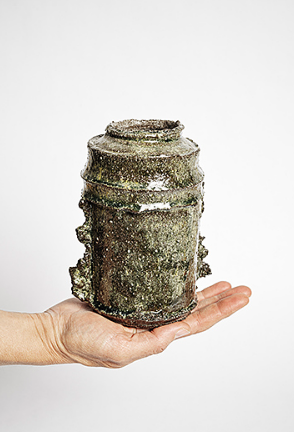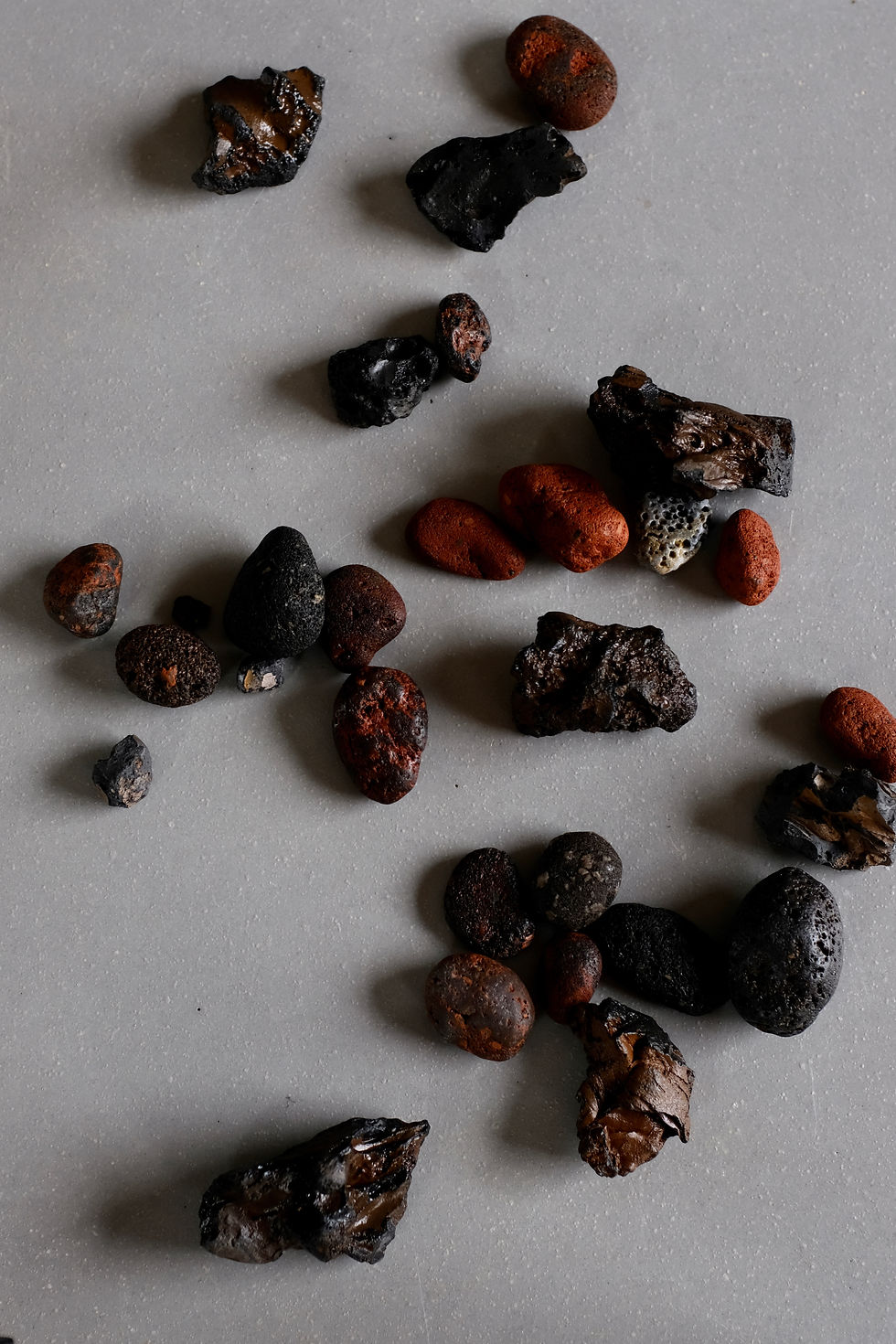
PLACE
This curated collection, part of our online Winter Exhibition 23/24, brings together a selection of artwork responding to place. From new experiences to where we belong, each artist in this collection seeks to capture an element of a place that means something to them, objects and canvas that are able to transport you.
"The journey I chose as inspiration was one I had made many times as a child up - a winding path up a steep mountain side in the alps. As the road climbed higher the glacier covered mountains on the opposite side of the valley came into view. These mountains always held a fascination for me - we were able to observe them as the snow coverage grew and receded with the seasons."
Barbara Sulzberger


"I'm renting a small room inside ArtHub Studio Woolwich. The building is located by the river and the best way to commute to it for me is walking or cycling. When I cycle by the river bank to the studio, I look at reflections on the water, shadows from old piers, dark brick walls of industrial buildings. And this is where inspiration to my brutal minimalistic black and white objects came from."
Olga Kudryavtseva

Most of the pieces include blends of stoneware bodies with local London Clay, hand prospected from the vicinity of the studio, which is used to create a physical link between the work and its place of creation and for the particular richness and subtlety of tone this material provides. Each piece is unique, being based on a single and unrepeated moment of inspiration."
Marek Pitera
"In late 2019 I moved from my studio in Camden to my current studio in High Barnet on the edge of London 6 months before the pandemic hit. The studio is located very close to ancient woodland “Hadley Woods” . During this period I continued to utilise the above techniques (which I describe as figurative expressionist / action painting) and inspired by the nature around me, began to move into the theme of trees."
"As my work is about capturing the etherial in energy and movement, I am fascinated to capture the peaceful feeling and effect of the seasons experienced when walking through woodland."
"I often go into the woods to make studies in Plein Aire (see gouache paintings ‘Explosion’ and ‘Autumn Dusk’), as well as the use of photography to inspire the production of larger paintings in my studio."
Beverley Isaacs

We don’t have any products to show here right now.

"Just outside Paris, where I live, millstone houses dominate the landscape. And yet, there are pockets of nature to be found from trees whose blossoms colour the streets pink or white in spring, and a little while later little explosions of red dot a background of urban yellow and beige: poppies that pop up wherever they want. I capture these little niches of nature in an urban setting in a vessel of black stoneware."
Jeanette Nguyen

"My work draws on my life experience as a child of Jamaican parents, growing up in inner city Bristol. I create ceramic art that is provocative, subversive, playful and humorous. I want to test interpretations of the present day, whilst producing tangible objects that contain a certain beauty and references a past."
"The ceramic milk bottles are adorned with my illustrations – a contemporary twist on the Willow Pattern - depicting scenes and people in my neighbourhood."
Claudette Forbes
"I walk and cycle near our home as much as I can and I’m often photographing when I’m outside. I worked a lot in photography towards the end of my degree, and it plays a big role in how I experiment with ideas and connect them together. I’ll intuitively take photographs, and often notice the relationship between them once I see them together. I notice strong architectural lines contrasting against leaves and trees, flowers peeking out from behind walls, layers of different flowers and foliage."
"Water also plays a role, we live close to the river and I’ll go there most days, it is very much a reset for me to be near water and there are definitely elements of this flow and connection running through the work."
Emily Marston


"Landscape painting always had its place in the hierarchy of artistic genres, being largely a reflection of what an artist sees in the outside world. These representations used to be fairly stable and changed only slightly through time. Now with the drastic transformation that climate change brings, many of these landscapes are disappearing forever."
"My work is an exploration of vanishing terrains around us. I make tactile canvases in ceramics. They are inspired by aerial footage of various lands that are slowly disappearing due to the climate crisis. Feeling helpless and pessimistic, I find solace in producing and reproducing magical landscapes of my imagination in clay. I find that ceramics offers the most direct route from imagination to an object in the world through the body and its material intelligence. Apart from clay coming directly from the depths of Earth, it is representative of the terrain it originates from. It carries within it the mineral marks and organic traces of history of a particular patch of land. I capture and frame these fragments of terrain to make them art - a material object stretching beyond individual memory."
Maryia Virshych



"I first started making work for my series Erosion after a trip to the Suffolk coast. In the shadow of the Sizewell nuclear reactor I came across an old fisherman’s hut, worn into abstract shapes by years of wind and sea erosion. Also on the beach were rocks and groins eroded into organic shapes. I then visited Covehithe Beach, where fallen trees have been sculpted by the elements. I became particularly interested in the effect the sea has on the earth and how we are completely at the mercy of this hugely powerful element. I have developed this series by using more layers of porcelain slip and glazes to create the effect of erosion."
Kirsty Wright (RAW86 Ceramics)
We don’t have any products to show here right now.

Shoreline is a series of hand-thrown stoneware vessels and domestic ware by David Stonehouse, inspired by pebbles found on his walks along the Suffolk and Pembrokeshire coasts. The inlaid coloured clay lines directly reference the veins in these stones, whilst also alluding to the waves and tide marks of the foreshore.
“Each piece has been created using local raw materials. A local shale known as Askam Grog, used to make bricks for homes in South Cumbria and wood dust from Cumbrian Oak trees, a waste product from a local traditional boatbuilder have been incorporated into the clay body. Hematite deposits used in the area’s steel industry have been crushed using a pestle and mortar to create an iron oxide which is applied to the surface underneath the artist’s own lava glaze.”
Kathryn Stevens makes sculptural forms influenced by technical drawings known as lofting plans used in the ship and boat building industries, creating a theme of work inspired by Cumbria’s natural and industrial landscape. Connecting with the viewer to tell a personal story of belonging, of the people and natural assets, the narrative of the place where she has lived since birth is the inspiration behind her work.

We don’t have any products to show here right now.

Verity’ Howards ‘Sacrificial Stone Series 2’ centres on the research of Alfred Watkins, a Herefordian naturalist from the early 1900’s. Watkins’ photographs and maps fascinate Verity, and this series title came from one of these maps. Verity was intrigued by the place name ‘Sacrificial Stone’, which to her evokes a sense of the surreal, stonelike, obscured and encaged. She has since been using clay to explore the images and feelings that she associates with these words.
Verity creates a stonelike surface on the works by applying texture and monoprinting using coloured slips. Verity evokes a feeling of these forms being obscured and encaged by layering further monoprints that reference grids and meshes. When slab building, she works intuitively, cutting up slabs of clay and collaging them together to create stonelike ceramic forms.


We don’t have any products to show here right now.


Susie Olczak's 'Armilla II' is inspired by time spent in the Guna Yala in Panama:
"This time in Guna Yala allowed for learning from an autonomous Indigenous matriarchal culture and experimentation with movement, dance, sound recordings, and have plants as the protagonists in performance work. On return to the UK from the research made during the residency a new body of physical and video work was created that celebrates connections between society and the non-human. Language and communication are a key consideration with regard to this research project. In Western society plants and land are seen and labelled as resources, whereas in indigenous communities plants are commonly viewed as a gift, and they believe in looking at nature not as a resource, but as a sort of kinship. Indigenous culture and the use of language promote restorative reciprocity and this healthy respectful relationship with nature is a key factor as we begin to navigate the effects of climate change."
We don’t have any products to show here right now.
"What would a forest immortalized in metal look like?"
"These gardens renew the concept of ecology by immortalizing the native vegetation of the forests of southern Chile. They contrast the vegetal contemplation and southern melancholy with the hardness and metallic shine, offering a hypnotic, elegant and alive work."
María Ignacia Walker

We don’t have any products to show here right now.
"I live near to the coast in Rye, I love to walk along the Rye harbour nature reserve that leads onto Camber Sands. It is a very special landscape rich in marine plants and birds. The salt marshes are found either side of the sea entrance to the harbour. They are a natural buffer from the high tides that regularly cover these low-lying beds. With climate change the tides rise 4mm a year and the seapurslane plant has adapted to this environment and flourishes in the salt rich land. Casting these plants in “down by the harbour edge” I wanted to show the fragility of our marine environments and the beauty of these coastal low living plants. Framed in a re purposed 'discarded window’ frame, sharing the importance of re-use, re-cycle to help tackle this climate emergency."
Joanna Terry


We don’t have any products to show here right now.
"Since we live in the heart of a national park in France, wilderness compose a major part of my illustrative work (we often see deers, birds of prey and woodpeckers in our gardens). Observing first hand not only wildlife manages complex interactions with humans but also the impact that industry has on the land through extraction and exploitation, I continue to develop a body of work questioning the dominant narratives which too often induce us in error regarding our concepts of time and place."
Michaëlla Smart





















































